Cameroon

Cameroon

| Capital | Yaoundé[1] |
|---|---|
| Largest city | Douala[1] |
| Official languages | English French |
| Cameroonian Pidgin English,Fula,Ewondo,Camfranglais | |
| Ethnic groups | |
| Demonym(s) | Cameroonian |
| Government | Unitarydominant-partypresidential republicunder anauthoritariandictatorship[2][3] |
| Paul Biya | |
| Joseph Ngute | |
| Legislature | Parliament |
| Senate | |
| National Assembly | |
| Independence | |
| 1 January 1960 | |
| 20 September 1960 | |
| 1 October 1961 | |
| Area | |
| 475,442 km (183,569 sq mi) (53rd) | |
| 0.57 | |
| Population | |
| 23,439,189[4](56th) | |
| 17,463,836[5] | |
| 39.7/km (102.8/sq mi) (167th) | |
| GDP | 2018 estimate |
| $95.068 billion[6](93rd) | |
| $3,820[6](152nd) | |
| GDP | 2018 estimate |
| $38.445 billion[6](98th) | |
| $1,544[6](152nd) | |
| Gini | 46.6[7] |
| HDI | |
| Currency | Central African CFA franc(XAF) |
| Time zone | (WAT) |
| Driving side | right |
| Calling code | +237 |
| ISO 3166 code | CM |
| Internet TLD | .cm |
Cameroon (/ˌkæməˈruːn/ ( listen); French: Cameroun), officially the Republic of Cameroon (French: République du Cameroun), is a country in Central Africa. It is bordered by Nigeria to the west and north; Chad to the northeast; the Central African Republic to the east; and Equatorial Guinea, Gabon and the Republic of the Congo to the south. Cameroon's coastline lies on the Bight of Biafra, part of the Gulf of Guinea and the Atlantic Ocean. Although Cameroon is not an ECOWAS member state, it is geographically and historically in West Africa with the Southern Cameroons which now form her Northwest and Southwest Regions having a strong West African history. The country is sometimes identified as West African and other times as Central African due to its strategic position at the crossroads between West and Central Africa. Cameroon is home to over 250 native languages spoken by nearly 20 million people.[9][10]
Early inhabitants of the territory included the Sao civilisation around Lake Chad and the Baka hunter-gatherers in the southeastern rainforest. Portuguese explorers reached the coast in the 15th century and named the area Rio dos Camarões (Shrimp River), which became Cameroon in English. Fulani soldiers founded the Adamawa Emirate in the north in the 19th century, and various ethnic groups of the west and northwest established powerful chiefdoms and fondoms. Cameroon became a German colony in 1884 known as Kamerun.
After World War I, the territory was divided between France and the United Kingdom as League of Nations mandates. The Union des Populations du Cameroun (UPC) political party advocated independence, but was outlawed by France in the 1950s, leading to the Bamileke War fought between French and UPC militant forces until early 1971. In 1960, the French-administered part of Cameroon became independent as the Republic of Cameroun under President Ahmadou Ahidjo. The southern part of British Cameroons federated with it in 1961 to form the Federal Republic of Cameroon. The federation was abandoned in 1972. The country was renamed the United Republic of Cameroon in 1972 and the Republic of Cameroon in 1984. Large numbers of Cameroonians live as subsistence farmers. Since 1975, Paul Biya has been ruling the country (as President since 1982), governing with his Cameroon People's Democratic Movement party. The country has experienced tensions coming from the English-speaking territories. Politicians in the English-speaking regions have advocated for greater decentralisation and even complete separation or independence (as in the Southern Cameroons National Council) from Cameroon. In 2017, tensions in the English-speaking territories escalated into open warfare.
The official languages of Cameroon are French and English, the languages of former colonial French Cameroons and British Cameroons and its religious population consists of 70% Christians and 20% Muslims. It is governed as a Unitary presidential republic and has good relations with the major powers of France, the United Kingdom and China.
The country is often referred to as "Africa in miniature" for its geological and cultural diversity.[11][12] Natural features include beaches, deserts, mountains, rainforests, and savannas. The highest point at almost 4,100 metres (13,500 ft) is Mount Cameroon in the Southwest Region of the country, and the largest cities in population-terms are Douala on the Wouri River, its economic capital and main seaport, Yaoundé, its political capital, and Garoua. The country is well known for its native styles of music, particularly Makossa and Bikutsi, and for its successful national football team. Cameroon is a member state of the African Union, the United Nations, Non-Aligned Movement and the Organisation of Islamic Cooperation.
| Capital | Yaoundé[1] |
|---|---|
| Largest city | Douala[1] |
| Official languages | English French |
| Cameroonian Pidgin English,Fula,Ewondo,Camfranglais | |
| Ethnic groups | |
| Demonym(s) | Cameroonian |
| Government | Unitarydominant-partypresidential republicunder anauthoritariandictatorship[2][3] |
| Paul Biya | |
| Joseph Ngute | |
| Legislature | Parliament |
| Senate | |
| National Assembly | |
| Independence | |
| 1 January 1960 | |
| 20 September 1960 | |
| 1 October 1961 | |
| Area | |
| 475,442 km (183,569 sq mi) (53rd) | |
| 0.57 | |
| Population | |
| 23,439,189[4](56th) | |
| 17,463,836[5] | |
| 39.7/km (102.8/sq mi) (167th) | |
| GDP | 2018 estimate |
| $95.068 billion[6](93rd) | |
| $3,820[6](152nd) | |
| GDP | 2018 estimate |
| $38.445 billion[6](98th) | |
| $1,544[6](152nd) | |
| Gini | 46.6[7] |
| HDI | |
| Currency | Central African CFA franc(XAF) |
| Time zone | (WAT) |
| Driving side | right |
| Calling code | +237 |
| ISO 3166 code | CM |
| Internet TLD | .cm |
History
The territory of present-day Cameroon was first settled during the Neolithic Era. The longest continuous inhabitants are groups such as the Baka (Pygmies).[13] From here, Bantu migrations into eastern, southern, and central Africa are believed to have originated about 2,000 years ago.[14] The Sao culture arose around Lake Chad, c. 500 AD, and gave way to the Kanem and its successor state, the Bornu Empire. Kingdoms, fondoms, and chiefdoms arose in the west.[15]
Portuguese sailors reached the coast in 1472. They noted an abundance of the ghost shrimp Lepidophthalmus turneranus in the Wouri River and named it Rio dos Camarões (Shrimp River), which became Cameroon in English.[16] Over the following few centuries, European interests regularised trade with the coastal peoples, and Christian missionaries pushed inland.[17]
1800s
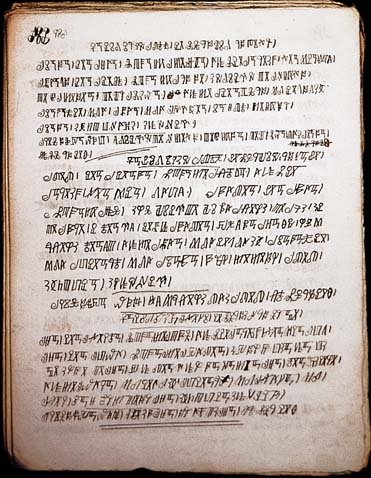
Bamum script is a writing system developed by King Njoya in the late 19th century
The Bamum tribe have a writing system, known as Bamum script or Shu Mom. The script was given to them by Sultan Ibrahim Njoya in 1896,[18][19] and is taught in Cameroon by the Bamum Scripts and Archives Project.[19] Germany began to establish roots in Cameroon in 1868 when the Woermann Company of Hamburg built a warehouse. It was built on the estuary of the Wouri River. Later Gustav Nachtigal made a treaty with one of the local kings to annex the region for the German emperor.[20] The German Empire claimed the territory as the colony of Kamerun in 1884 and began a steady push inland. The Germans ran into resistance with the native people who did not want the Germans to establish themselves on this land. Under the influence of Germany, commercial companies were left to regulate local administrations. These concessions used forced labour of the Africans to make a profit. The labour was used on banana, rubber, palm oil, and cocoa plantations.[20] They initiated projects to improve the colony's infrastructure, relying on a harsh system of forced labour, which was much criticised by the other colonial powers.[21]
1900s
With the defeat of Germany in World War I, Kamerun became a League of Nations mandate territory and was split into French Cameroons and British Cameroons in 1919. France integrated the economy of Cameroon with that of France[22] and improved the infrastructure with capital investments and skilled workers, modifying the colonial system of forced labour.[21]
The British administered their territory from neighbouring Nigeria. Natives complained that this made them a neglected "colony of a colony". Nigerian migrant workers flocked to Southern Cameroons, ending forced labour altogether but angering the local natives, who felt swamped.[23] The League of Nations mandates were converted into United Nations Trusteeships in 1946, and the question of independence became a pressing issue in French Cameroun.[22]
France outlawed the pro-independence political party, the Union des Populations du Cameroun (UPC), on 13 July 1955.[24] Armed response by the colonialists prompted a long guerrilla war (known also as the Bamileke War) and the assassination of several of the party's leaders, including Ruben Um Nyobè, Félix-Roland Moumié and Ernest Ouandie. In the British Cameroons, the question was whether to reunify with French Cameroun or join Nigeria.[25]
Independence (1960)
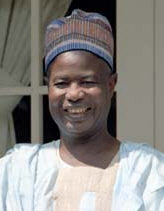
Former president Ahmadou Ahidjo ruled from 1960 until 1982.
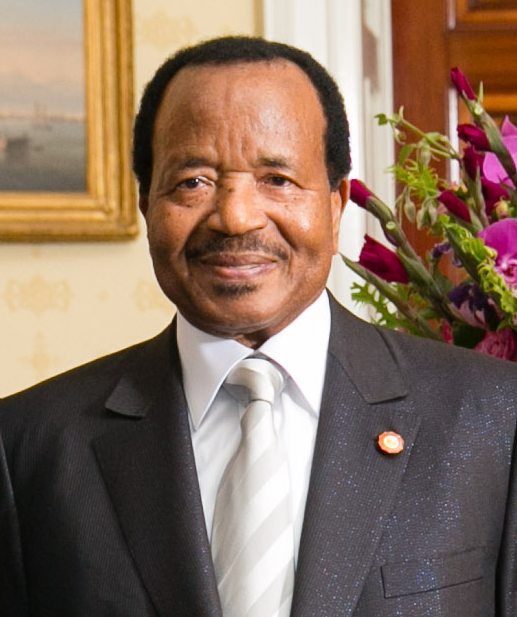
Paul Biya has ruled the country since 1982
On 1 January 1960, French Cameroun gained independence from France under President Ahmadou Ahidjo. On 1 October 1961, the formerly British Southern Cameroons gained independence voted by vote of the UN General Assembly and joined with French Cameroun to form the Federal Republic of Cameroon, a date which is now observed as Unification Day, a public holiday.[26] Ahidjo used the ongoing war with the UPC to concentrate power in the presidency, continuing with this even after the suppression of the UPC in 1971.[27]
His political party, the Cameroon National Union (CNU), became the sole legal political party on 1 September 1966 and on 20 May 1972, a referendum was passed to abolish the federal system of government in favour of a United Republic of Cameroon, headed from Yaoundé.[28] This day is now the country's National Day, a public holiday.[29] Ahidjo pursued an economic policy of planned liberalism, prioritising cash crops and petroleum development. The government used oil money to create a national cash reserve, pay farmers, and finance major development projects; however, many initiatives failed when Ahidjo appointed unqualified allies to direct them.[30]
Ahidjo stepped down on 4 November 1982 and left power to his constitutional successor, Paul Biya. However, Ahidjo remained in control of the CNU and tried to run the country from behind the scenes until Biya and his allies pressured him into resigning. Biya began his administration by moving toward a more democratic government, but a failed coup d'état nudged him toward the leadership style of his predecessor.[31]
An economic crisis took effect in the mid-1980s to late 1990s as a result of international economic conditions, drought, falling petroleum prices, and years of corruption, mismanagement, and cronyism. Cameroon turned to foreign aid, cut government spending, and privatised industries. With the reintroduction of multi-party politics in December 1990, the former British Southern Cameroons pressure groups called for greater autonomy, and the Southern Cameroons National Council advocated complete secession as the Republic of Ambazonia.[32]
21st century
In June 2006, talks concerning a territorial dispute over the Bakassi peninsula were resolved. The talks involved President Paul Biya of Cameroon, then President Olusegun Obasanjo of Nigeria and then UN Secretary General Kofi Annan, and resulted in Cameroonian control of the oil-rich peninsula. The northern portion of the territory was formally handed over to the Cameroonian government in August 2006, and the remainder of the peninsula was left to Cameroon 2 years later, in 2008.[33] The boundary change triggered a local separatist insurgency, as many Bakassians refused to accept Cameroonian rule. While most militants laid down their arms in November 2009,[34] some carried on fighting for years.[35]
In May 2014, in the wake of the Chibok schoolgirls kidnapping, presidents Paul Biya of Cameroon and Idriss Déby of Chad announced they are waging war on Boko Haram, and deployed troops to the Nigerian border.[38] Boko Haram launched several attacks into Cameroon, killing 84 civilians in a December 2014 raid, but suffering a heavy defeat in a raid in January, 2015. Cameroon declared victory over Boko Haram on Cameroonian territory in September 2018.[39]
Since November 2016, protesters from the predominantly English-speaking Northwest and Southwest regions of the country have been campaigning for continued use of the English language in schools and courts. People were killed and hundreds jailed as a result of these protests.[40] In 2017, Biya's government blocked the regions' access to the Internet for three months.[41] In September, separatists started a guerilla war for the indendence of the Anglophone region as the Federal Republic of Ambazonia. The government responded with a military offensive, and the insurgency spread across the Northwest and Southwest regions. As of 2019, fighting between separatist guerillas and government forces continues.[42] Since 2016, more than 450,000 people have fled their homes.[43] The conflict indirectly led to an upsurge in Boko Haram attacks, as the Cameroonian military largely withdrew from the north to focus on fighting the Ambazonian separatists.[44]
Politics and government

Unity Palace – Cameroon Presidency.
The President of Cameroon is elected and creates policy, administers government agencies, commands the armed forces, negotiates and ratifies treaties, and declares a state of emergency.[45] The president appoints government officials at all levels, from the prime minister (considered the official head of government), to the provincial governors and divisional officers.[46] The president is selected by popular vote every seven years.[1] There have been 2 presidents since the independence of Cameroon.
The 1996 constitution establishes a second house of parliament, the 100-seat Senate, was established in April 2013 and is headed by a President of the Senate who is the constitutional successor in case of untimely vacancy of the Presidency of the Republic.[1] The government recognises the authority of traditional chiefs, fons, and lamibe to govern at the local level and to resolve disputes as long as such rulings do not conflict with national law.[14][48]
Cameroon's legal system is largely based on French civil law with common law influences.[1] Although nominally independent, the judiciary falls under the authority of the executive's Ministry of Justice.[14] The president appoints judges at all levels.[46] The judiciary is officially divided into tribunals, the court of appeal, and the supreme court. The National Assembly elects the members of a nine-member High Court of Justice that judges high-ranking members of government in the event they are charged with high treason or harming national security.[49][50]
Political culture
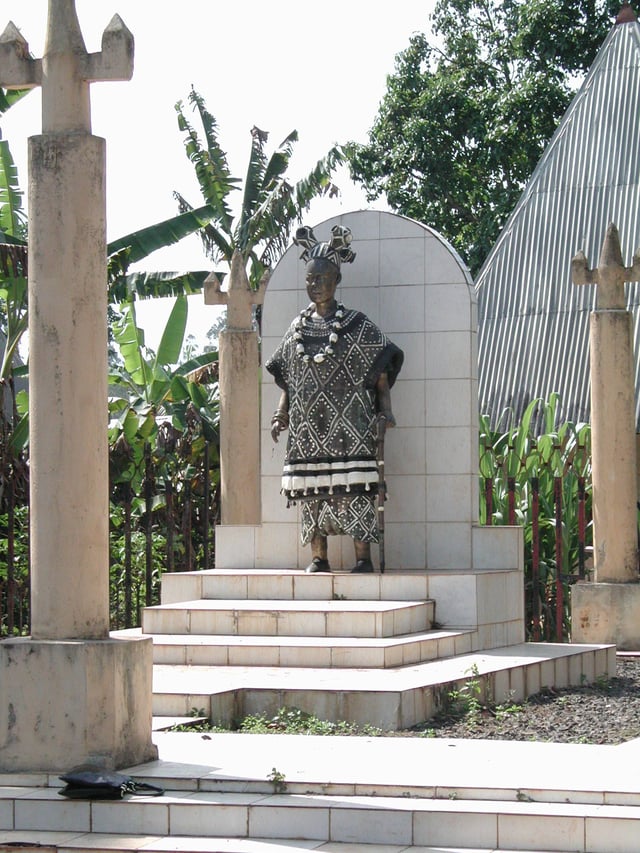
A statue of a chief in Bana, West Region.
Cameroon is viewed as rife with corruption at all levels of government.
In 1997, Cameroon established anti-corruption bureaus in 29 ministries, but only 25% became operational,[51] and in 2012, Transparency International placed Cameroon at number 144 on a list of 176 countries ranked from least to most corrupt.[52] On 18 January 2006, Biya initiated an anti-corruption drive under the direction of the National Anti-Corruption Observatory.[51] There are several high corruption risk areas in Cameroon, for instance, customs, public health sector and public procurement.[53] However, the corruption has gotten worse, regardless of the existing anti-corruption bureaus, as Transparency International ranked Cameroon 152 on a list of 180 countries in 2018.[54]
President Biya's Cameroon People's Democratic Movement (CPDM) was the only legal political party until December 1990. Numerous regional political groups have since formed. The primary opposition is the Social Democratic Front (SDF), based largely in the Anglophone region of the country and headed by John Fru Ndi.[55]
Biya and his party have maintained control of the presidency and the National Assembly in national elections, which rivals contend were unfair.[32] Human rights organisations allege that the government suppresses the freedoms of opposition groups by preventing demonstrations, disrupting meetings, and arresting opposition leaders and journalists.[56][57] In particular, English-speaking people are discriminated against; protests often escalate into violent clashes and killings.[58] In 2017, President Biya shut down the Internet in the English-speaking region for 94 days, at the cost of hampering five million people, including Silicon Mountain startups.[59]
Human rights
Human rights organisations accuse police and military forces of mistreating and even torturing criminal suspects, ethnic minorities, homosexuals, and political activists.[56][57][62][63] Prisons are overcrowded with little access to adequate food and medical facilities,[62][63] and prisons run by traditional rulers in the north are charged with holding political opponents at the behest of the government.[57] However, since the first decade of the 21st century, an increasing number of police and gendarmes have been prosecuted for improper conduct.[62]
Same-sex sexual acts are banned by section 347-1 of the penal code with a penalty of from 6 months up to 5 years' imprisonment.[65]
Foreign relations
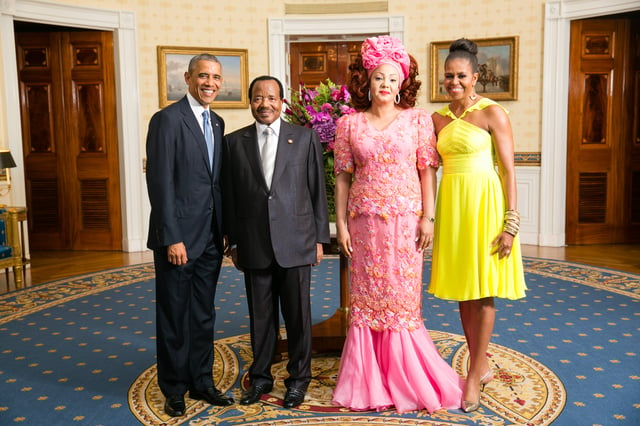
President Paul Biya with U.S. President Barack Obama in 2014
Cameroon is a member of both the Commonwealth of Nations and La Francophonie.
President Biya has engaged in a decades-long clash with the government of Nigeria over possession of the oil-rich Bakassi peninsula.[55] Cameroon and Nigeria share a 1,000-mile (1 600 km) border and have disputed the sovereignty of the Bakassi peninsula. In 1994 Cameroon petitioned the International Court of Justice to resolve the dispute. The two countries attempted to establish a cease-fire in 1996, however, fighting continued for years. In 2002, the ICJ ruled that the Anglo-German Agreement of 1913 gave sovereignty to Cameroon. The ruling called for a withdrawal by both countries and denied the request by Cameroon for compensation due to Nigeria's long-term occupation.[69] By 2004, Nigeria had failed to meet the deadline to handover the peninsula. A UN-mediated summit in June 2006 facilitated an agreement for Nigeria to withdraw from the region and both leaders signed the Greentree Agreement.[70] The withdrawal and handover of control was completed by August 2006.[71]
Administrative divisions

Cameroon is divided into 10 regions.
The constitution divides Cameroon into 10 semi-autonomous regions, each under the administration of an elected Regional Council. Each region is headed by a presidentially appointed governor.[45]
These leaders are charged with implementing the will of the president, reporting on the general mood and conditions of the regions, administering the civil service, keeping the peace, and overseeing the heads of the smaller administrative units.
Governors have broad powers: they may order propaganda in their area and call in the army, gendarmes, and police.[45] All local government officials are employees of the central government's Ministry of Territorial Administration, from which local governments also get most of their budgets.[14]
The regions are subdivided into 58 divisions (French départements). These are headed by presidentially appointed divisional officers (préfets). The divisions are further split into sub-divisions (arrondissements), headed by assistant divisional officers (sous-prefets). The districts, administered by district heads (chefs de district), are the smallest administrative units.[73]
The three northernmost regions are the Far North (Extrême Nord), North (Nord), and Adamawa (Adamaoua). Directly south of them are the Centre (Centre) and East (Est). The South Province (Sud) lies on the Gulf of Guinea and the southern border. Cameroon's western region is split into four smaller regions: the Littoral (Littoral) and Southwest (Sud-Ouest) regions are on the coast, and the Northwest (Nord-Ouest) and West (Ouest) regions are in the western grassfields.[73]
Education and health
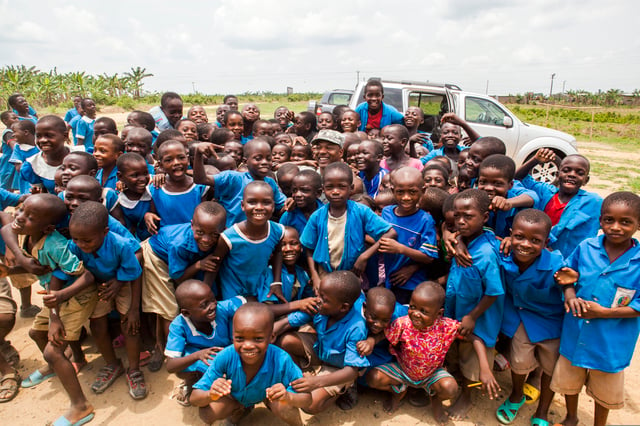
School children in Cameroon.
In 2013, the total adult literacy rate of Cameroon was estimated to be 71.3%. Among youths age 15–24 the literacy rate was 85.4% for males and 76.4% for females.[74] Most children have access to state-run schools that are cheaper than private and religious facilities.[75] The educational system is a mixture of British and French precedents[76] with most instruction in English or French.[77]
Cameroon has one of the highest school attendance rates in Africa.[75] Girls attend school less regularly than boys do because of cultural attitudes, domestic duties, early marriage, pregnancy, and sexual harassment.
Although attendance rates are higher in the south,[75] a disproportionate number of teachers are stationed there, leaving northern schools chronically understaffed.[62] In 2013, the primary school enrollment rate was 93.5%.[74]
School attendance in Cameroon is also affected by child labour. Indeed, the United States Department of Labor Findings on the Worst Forms of Child Labor reported that 56% of children aged 5 to 14 were working children and that almost 53% of children aged 7 to 14 combined work and school.[78] In December 2014, a List of Goods Produced by Child Labor or Forced Labor issued by the Bureau of International Labor Affairs mentioned Cameroon among the countries that resorted to child labor in the production of cocoa.[79]
The quality of health care is generally low.[80] Life expectancy at birth is estimated to be 56 years in 2012, with 48 healthy life years expected.[81] Fertility rate remain high in Cameroon with an average of 4.8 births per woman and an average mothers' age of 19.7 years old at first birth.[81] In Cameroon, there is only one doctor for every 5,000 people, according to the World Health Organization.[82] In 2014, just 4.1% of total GDP expenditure was allocated to healthcare.[83] Due to financial cuts in the health care system, there are few professionals. Doctors and nurses who were trained in Cameroon, emigrate because in Cameroon the payment is poor while the workload is high. Nurses are unemployed even though their help is needed. Some of them help out voluntarily so they will not lose their skills.[84] Outside the major cities, facilities are often dirty and poorly equipped.[85]
In 2012, the top three deadly diseases were HIV/AIDS, Lower Respiratory Infection, and Diarrheal Diseases.[81] Endemic diseases include dengue fever, filariasis, leishmaniasis, malaria, meningitis, schistosomiasis, and sleeping sickness.[86] The HIV/AIDS prevalence rate in 2016 was estimated at 3.8% for those aged 15–49,[87] although a strong stigma against the illness keeps the number of reported cases artificially low.[80] 46,000 children under age 14 were estimated to be living with HIV in 2016. In Cameroon, 58% of those living with HIV know their status, and just 37% receive ARV treatment. In 2016, 29,000 death due to AIDS occurred in both adults and children.[87]
Breast ironing, a traditional practice that is prevalent in Cameroon, may affect girls' health.[88][89][90][91] Female genital mutilation (FGM), while not widespread, is practiced among some populations; according to a 2013 UNICEF report,[92] 1% of women in Cameroon have undergone FGM. Also impacting women and girls' health, the contraceptive prevalence rate is estimated to be just 34.4% in 2014. Traditional healers remain a popular alternative to evidence-based medicine.[93]
Geography

Cameroon map of Köppen climate classification.
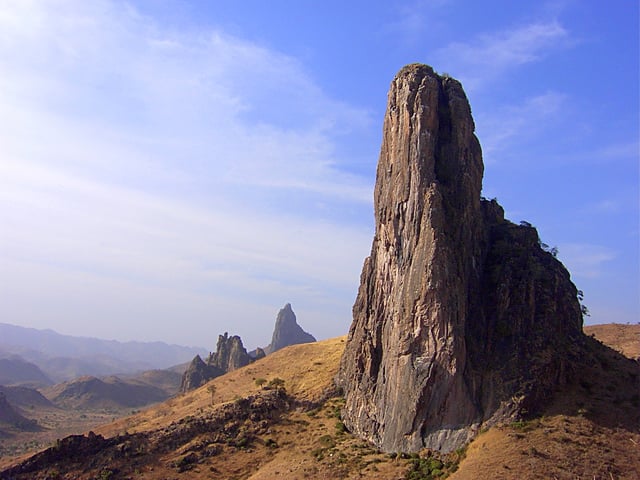
Volcanic plugs dot the landscape near Rhumsiki, Far North Region.
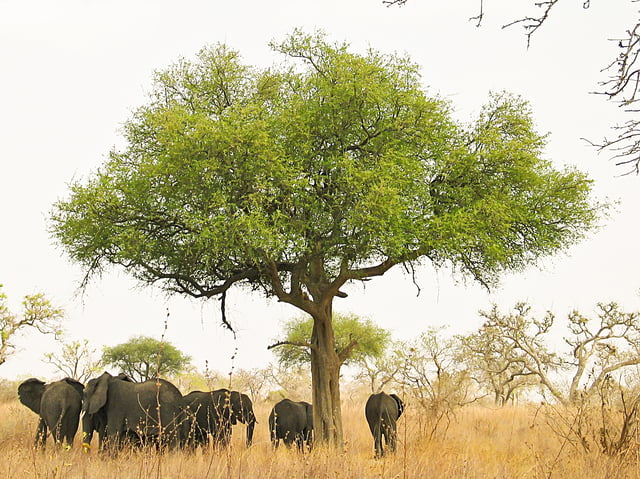
Elephants in Waza National Park.
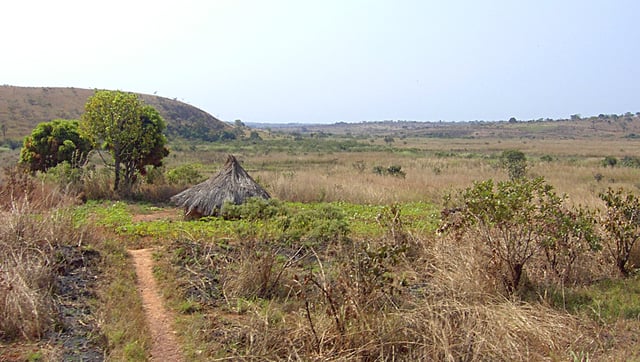
Countryside near Ngaoundal in Cameroon's Adamawa Region.
At 475,442 square kilometres (183,569 sq mi), Cameroon is the world's 53rd-largest country.[94] It is slightly larger than the nation of Sweden and the state of California; Cameroon is comparable in size to Papua New Guinea. The country is located in Central and West Africa, known as the hinge of Africa, on the Bight of Bonny, part of the Gulf of Guinea and the Atlantic Ocean.[95] Cameroon lies between latitudes 1° and 13°N, and longitudes 8° and 17°E. Cameroon controls 12 nautical miles of the Atlantic Ocean.
Tourist literature describes Cameroon as "Africa in miniature" because it exhibits all major climates and vegetation of the continent: coast, desert, mountains, rainforest, and savanna.[77] The country's neighbours are Nigeria and the Atlantic Ocean to the west; Chad to the northeast; the Central African Republic to the east; and Equatorial Guinea, Gabon and the Republic of the Congo to the south.[1]
Cameroon is divided into five major geographic zones distinguished by dominant physical, climatic, and vegetative features.
The coastal plain extends 15 to 150 kilometres (9 to 93 mi) inland from the Gulf of Guinea[97] and has an average elevation of 90 metres (295 ft).[98] Exceedingly hot and humid with a short dry season, this belt is densely forested and includes some of the wettest places on earth, part of the Cross-Sanaga-Bioko coastal forests.[99][100]
The South Cameroon Plateau rises from the coastal plain to an average elevation of 650 metres (2,133 ft).[77] Equatorial rainforest dominates this region, although its alternation between wet and dry seasons makes it is less humid than the coast. This area is part of the Atlantic Equatorial coastal forests ecoregion.[102]
An irregular chain of mountains, hills, and plateaus known as the Cameroon range extends from Mount Cameroon on the coast—Cameroon's highest point at 4,095 metres (13,435 ft)[103]—almost to Lake Chad at Cameroon's northern border at 13°05'N. This region has a mild climate, particularly on the Western High Plateau, although rainfall is high. Its soils are among Cameroon's most fertile, especially around volcanic Mount Cameroon.[103] Volcanism here has created crater lakes. On 21 August 1986, one of these, Lake Nyos, belched carbon dioxide and killed between 1,700 and 2,000 people.[104] This area has been delineated by the World Wildlife Fund as the Cameroonian Highlands forests ecoregion.[105]
The southern plateau rises northward to the grassy, rugged Adamawa Plateau. This feature stretches from the western mountain area and forms a barrier between the country's north and south. Its average elevation is 1,100 metres (3,609 ft),[77] and its average temperature ranges from 22 °C (71.6 °F) to 25 °C (77 °F) with high rainfall between April and October peaking in July and August.[106][107] The northern lowland region extends from the edge of the Adamawa to Lake Chad with an average elevation of 300 to 350 metres (984 to 1,148 ft).[103] Its characteristic vegetation is savanna scrub and grass. This is an arid region with sparse rainfall and high median temperatures.[108]
Cameroon has four patterns of drainage.
In the south, the principal rivers are the Ntem, Nyong, Sanaga, and Wouri. These flow southwestward or westward directly into the Gulf of Guinea. The Dja and Kadéï drain southeastward into the Congo River. In northern Cameroon, the Bénoué River runs north and west and empties into the Niger. The Logone flows northward into Lake Chad, which Cameroon shares with three neighbouring countries.[109]
Economy and infrastructure

Douala
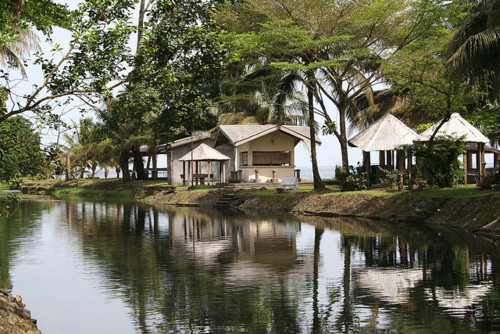
A touristic area in Limbe
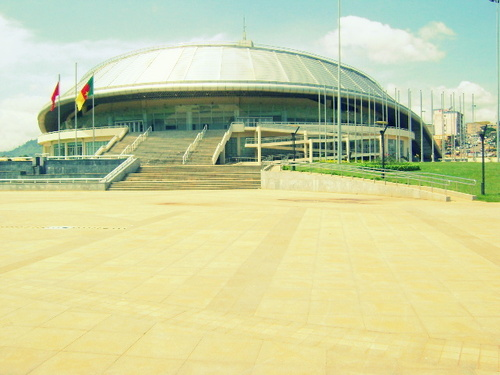
Yaoundé Sport palace
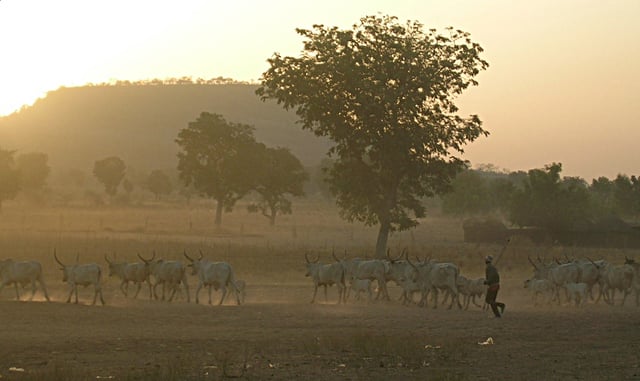
A Fulani herder drives his cattle in northern Cameroon.
Cameroon's per-capita GDP (Purchasing power parity) was estimated as US$2,300 in 2008,[1] one of the ten highest in sub-Saharan Africa.[110] Major export markets include France, Italy, South Korea, Spain, and the United Kingdom.[1] Cameroon is aiming to become an emerging country by 2035.
Cameroon has had a decade of strong economic performance, with GDP growing at an average of 4% per year.
During the 2004–2008 period, public debt was reduced from over 60% of GDP to 10% and official reserves quadrupled to over US$3 billion.[111] Cameroon is part of the Bank of Central African States (of which it is the dominant economy),[110] the Customs and Economic Union of Central Africa (UDEAC) and the Organization for the Harmonization of Business Law in Africa (OHADA).[112] Its currency is the CFA franc.[1]
Unemployment was estimated at 4.4% in 2014,[83] and about a third of the population was living below the international poverty threshold of US$1.25 a day in 2009.[114] Since the late 1980s, Cameroon has been following programmes advocated by the World Bank and International Monetary Fund (IMF) to reduce poverty, privatise industries, and increase economic growth.[14] The government has taken measures to encourage tourism in the country.[115]
Cameroon's natural resources are very well suited to agriculture and arboriculture.
An estimated 70% of the population farms, and agriculture comprised an estimated 19.8% of GDP in 2009.[1] Most agriculture is done at the subsistence scale by local farmers using simple tools.
They sell their surplus produce, and some maintain separate fields for commercial use.
Urban centres are particularly reliant on peasant agriculture for their foodstuffs.
Soils and climate on the coast encourage extensive commercial cultivation of bananas, cocoa, oil palms, rubber, and tea.
Inland on the South Cameroon Plateau, cash crops include coffee, sugar, and tobacco.
Coffee is a major cash crop in the western highlands, and in the north, natural conditions favour crops such as cotton, groundnuts, and rice.
Reliance on agricultural exports makes Cameroon vulnerable to shifts in their prices.[1]
Livestock are raised throughout the country.[116] Fishing employs 5,000 people and provides over 100,000 tons of seafood each year.[117][118] Bushmeat, long a staple food for rural Cameroonians, is today a delicacy in the country's urban centres. The commercial bushmeat trade has now surpassed deforestation as the main threat to wildlife in Cameroon.[119][120]
The southern rainforest has vast timber reserves, estimated to cover 37% of Cameroon's total land area.[118] However, large areas of the forest are difficult to reach.
Logging, largely handled by foreign-owned firms,[118] provides the government US$60 million a year in taxes (as of 1998), and laws mandate the safe and sustainable exploitation of timber.
Nevertheless, in practice, the industry is one of the least regulated in Cameroon.[121]
Factory-based industry accounted for an estimated 29.7% of GDP in 2009.[1] More than 75% of Cameroon's industrial strength is located in Douala and Bonabéri. Cameroon possesses substantial mineral resources, but these are not extensively mined (see Mining in Cameroon).[14] Petroleum exploitation has fallen since 1986, but this is still a substantial sector such that dips in prices have a strong effect on the economy.[122] Rapids and waterfalls obstruct the southern rivers, but these sites offer opportunities for hydroelectric development and supply most of Cameroon's energy. The Sanaga River powers the largest hydroelectric station, located at Edéa. The rest of Cameroon's energy comes from oil-powered thermal engines. Much of the country remains without reliable power supplies.[123]
Transport in Cameroon is often difficult. Except for the several relatively good toll roads which connect major cities (all of them one-lane) roads are poorly maintained and subject to inclement weather, since only 10% of the roadways are tarred.[1] Roadblocks often serve little other purpose than to allow police and gendarmes to collect bribes from travellers.[124] Road banditry has long hampered transport along the eastern and western borders, and since 2005, the problem has intensified in the east as the Central African Republic has further destabilised.[125]
Intercity bus services run by multiple private companies connect all major cities. They are the most popular means of transportation followed by the rail service Camrail. Rail service runs from Kumba in the west to Bélabo in the east and north to Ngaoundéré.[126] International airports are located in Douala and Yaoundé, with a third under construction in Maroua.[127] Douala is the country's principal seaport.[128] In the north, the Bénoué River is seasonally navigable from Garoua across into Nigeria.[129]
Although press freedoms have improved since the first decade of the 21st century, the press is corrupt and beholden to special interests and political groups.[130] Newspapers routinely self-censor to avoid government reprisals.[62] The major radio and television stations are state-run and other communications, such as land-based telephones and telegraphs, are largely under government control.[131] However, cell phone networks and Internet providers have increased dramatically since the first decade of the 21st century[132] and are largely unregulated.[57]
Military
The Cameroon Armed Forces, (French: Forces armées camerounaises, FAC) as of 2015, consists of the country's army (French: Armée de Terre), the country's navy (French: Marine Nationale de la République (MNR), includes naval infantry), the Cameroonian Air Force (French: Armée de l'Air du Cameroun, AAC), Fire Fighter Corps, Rapid Intervention Brigade and the Gendarmerie.[1]
Males and females that are 18 years of age up to 23 years of age and have graduated high school are eligible for military service.
Those who join are obliged to complete 4 years of service.
There is no conscription in Cameroon, but the government makes periodic calls for volunteers.[1]
Demographics
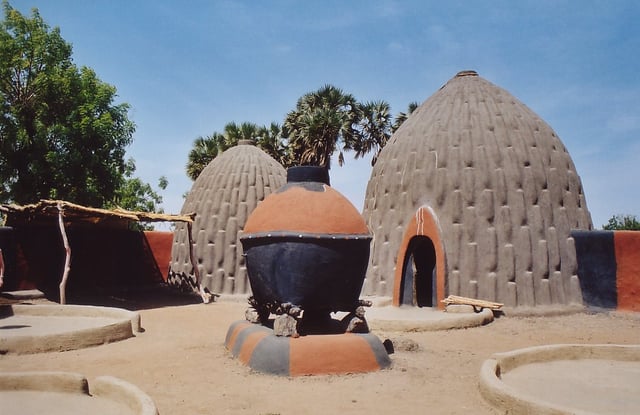
The homes of the Musgum, in the Far North Region, are made of earth and grass.
| Population[134] | |||
|---|---|---|---|
| Year | Million | ||
| 1971 | 7.0 | ||
| 1990 | 12.2 | ||
| 2009 | 19.5 | ||
| 2016 | 23.4 | ||
| Source: OECD/World Bank | |||
According to the latest census, Cameroon still has slightly more women (50.6%) than men (49.4%).
Nearly 60% of the population is under age 25.
People over 65 years of age account for only 3.2% of the total population.[1]
Cameroon's population is almost evenly divided between urban and rural dwellers.[135] Population density is highest in the large urban centres, the western highlands, and the northeastern plain.[136] Douala, Yaoundé, and Garoua are the largest cities. In contrast, the Adamawa Plateau, southeastern Bénoué depression, and most of the South Cameroon Plateau are sparsely populated.[137]
According to the World Health Organization, the fertility rate was 4.8 in 2013 with a population growth rate of 2.56%.[81]
People from the overpopulated western highlands and the underdeveloped north are moving to the coastal plantation zone and urban centres for employment.[76] Smaller movements are occurring as workers seek employment in lumber mills and plantations in the south and east.[139] Although the national sex ratio is relatively even, these out-migrants are primarily males, which leads to unbalanced ratios in some regions.[140]
Both monogamous and polygamous marriage are practised, and the average Cameroonian family is large and extended.[141] In the north, women tend to the home, and men herd cattle or work as farmers. In the south, women grow the family's food, and men provide meat and grow cash crops. Cameroonian society is male-dominated, and violence and discrimination against women is common.[57][62][142]
Estimates identify anywhere from 230 to 282 different folks and linguistic groups in Cameroon.[143][144] The Adamawa Plateau broadly bisects these into northern and southern divisions. The northern peoples are Sudanese groups, who live in the central highlands and the northern lowlands, and the Fulani, who are spread throughout northern Cameroon. A small number of Shuwa Arabs live near Lake Chad. Southern Cameroon is inhabited by speakers of Bantu and Semi-Bantu languages. Bantu-speaking groups inhabit the coastal and equatorial zones, while speakers of Semi-Bantu languages live in the Western grassfields. Some 5,000 Gyele and Baka Pygmy peoples roam the southeastern and coastal rainforests or live in small, roadside settlements.[145] Nigerians make up the largest group of foreign nationals.[146]
Refugees
In 2007, Cameroon hosted a total population of refugees and asylum seekers of approximately 97,400.
Of these, 49,300 were from the Central African Republic (many driven west by war),[148] 41,600 from Chad, and 2,900 from Nigeria.[149] Kidnappings of Cameroonian citizens by Central African bandits have increased since 2005.[125]
In the first months of 2014, thousands of refugees fleeing the violence in the Central African Republic arrived in Cameroon.[150]
On 4 June 2014, AlertNet reported:
Almost 90,000 people have fled to neighbouring Cameroon since December and up to 2,000 a week, mostly women and children, are still crossing the border, the United Nations said.
"Women and children are arriving in Cameroon in a shocking state, after weeks, sometimes months, on the road, foraging for food," said Ertharin Cousin, executive director of the World Food Programme (WFP).[151]
Languages
Both English and French are official languages, although French is by far the most understood language (more than 80%).[152] German, the language of the original colonisers, has long since been displaced by French and English.
Cameroonian Pidgin English is the lingua franca in the formerly British-administered territories.[153] A mixture of English, French, and Pidgin called Camfranglais has been gaining popularity in urban centres since the mid-1970s.[154][155] The government encourages bilingualism in English and French, and as such, official government documents, new legislation, ballots, among others, are written and provided in both languages. As part of the initiative to encourage bilingualism in Cameroon, six of the eight universities in the country are entirely bilingual.
In 2017 there were language protests by the anglophone population against perceived oppression by the francophone.[156] The military was deployed against the protesters and people have been killed, hundreds imprisoned and thousands fled the country.[157] This has since evolved into the Anglophone Crisis.[156]
Religion
Cameroon has a high level of religious freedom and diversity.[62] The predominant faith is Christianity, practised by about two-thirds of the population, while Islam is a significant minority faith, adhered to by about one-fifth. In addition, traditional faiths are practised by many. Muslims are most concentrated in the north, while Christians are concentrated primarily in the southern and western regions, but practitioners of both faiths can be found throughout the country.[159] Large cities have significant populations of both groups.[159] Muslims in Cameroon are divided into Sufis (and Salafis),[160] Shias, and non-denominational Muslims.[160][161]
People from the North-West and South-West provinces, which used to be a part of British Cameroons, have the highest proportion of Protestants. The French-speaking regions of the southern and western regions are largely Catholic.[159] Southern ethnic groups predominantly follow Christian or traditional African animist beliefs, or a syncretic combination of the two. People widely believe in witchcraft, and the government outlaws such practices.[162] Suspected witches are often subject to mob violence.[62] The Islamist jihadist group Ansar al-Islam has been reported as operating in North Cameroon.[163]
In the northern regions, the locally dominant Fulani ethnic group is mostly Muslim, but the overall population is fairly evenly divided among Muslims, Christians, and followers of indigenous religious beliefs (called Kirdi ("pagan") by the Fulani).[159] The Bamum ethnic group of the West Region is largely Muslim.[159] Native traditional religions are practised in rural areas throughout the country but rarely are practised publicly in cities, in part because many indigenous religious groups are intrinsically local in character.[159]
The Norwegian Missionary Society first established a mission in Cameroon in the early 1920s.
Many of its churches still stand.
At the time there were few Christians but now there are many.
In cooperation with the local Evangelical Lutheran Church of Cameroon EELC and the American ELCA the NMS built several hospitals among these the Protestant Hospital of Ngaoundéré, high schools and several other institutions.
Ngaoundéré once held one of the largest Norwegian contingencies of any place in the world, with over 100 Norwegians living there in the 1980s.
Some of the families have been there in several generations among these Kaldhol, Bjaanes, Stavenjord and Dankel.
The neighbourhood was even dubbed "Norvège" ("Norway" in French).
Culture
Media
Music and dance
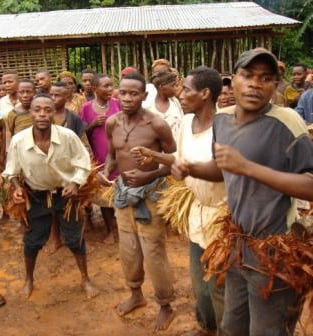
Dancers greet visitors to the East Region.
Music and dance are an integral part of Cameroonian ceremonies, festivals, social gatherings, and storytelling.[164][165] Traditional dances are highly choreographed and separate men and women or forbid participation by one sex altogether.[166] The goals of dances range from pure entertainment to religious devotion.[165] Traditionally, music is transmitted orally. In a typical performance, a chorus of singers echoes a soloist.[167]
Musical accompaniment may be as simple as clapping hands and stomping feet,[168] but traditional instruments include bells worn by dancers, clappers, drums and talking drums, flutes, horns, rattles, scrapers, stringed instruments, whistles, and xylophones; the exact combination varies with ethnic group and region. Some performers sing complete songs by themselves, accompanied by a harplike instrument.[167][169]
Popular music styles include ambasse bey of the coast, assiko of the Bassa, mangambeu of the Bangangte, and tsamassi of the Bamileke.[170] Nigerian music has influenced Anglophone Cameroonian performers, and Prince Nico Mbarga's highlife hit "Sweet Mother" is the top-selling African record in history.[171]
The two most popular styles of music are makossa and bikutsi. Makossa developed in Douala and mixes folk music, highlife, soul, and Congo music. Performers such as Manu Dibango, Francis Bebey, Moni Bilé, and Petit-Pays popularised the style worldwide in the 1970s and 1980s. Bikutsi originated as war music among the Ewondo. Artists such as Anne-Marie Nzié developed it into a popular dance music beginning in the 1940s, and performers such as Mama Ohandja and Les Têtes Brulées popularised it internationally during the 1960s, 1970s, and 1980s.[172][173]
Cuisine
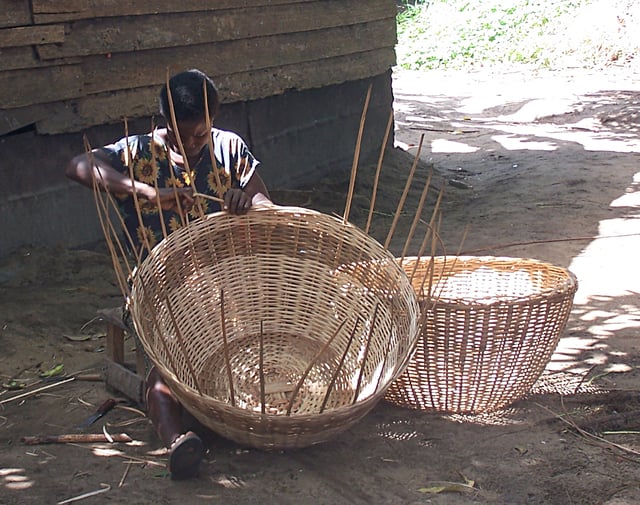
A woman weaves a basket near Lake Ossa, Littoral Region. Cameroonians practise such handicrafts throughout the country.
Cuisine varies by region, but a large, one-course, evening meal is common throughout the country. A typical dish is based on cocoyams, maize, cassava (manioc), millet, plantains, potatoes, rice, or yams, often pounded into dough-like fufu. This is served with a sauce, soup, or stew made from greens, groundnuts, palm oil, or other ingredients.[174] Meat and fish are popular but expensive additions, with chicken often reserved for special occasions.[175] Dishes are often quite hot, spiced with salt, red pepper sauce, and Maggi.[176][177][178]
Cutlery is common, but food is traditionally manipulated with the right hand.
Breakfast consists of leftovers of bread and fruit with coffee or tea. Generally breakfast is made from wheat flour in various different foods such as puff-puff (doughnuts), accra banana made from bananas and flour, bean cakes and many more. Snacks are popular, especially in larger towns where they may be bought from street vendors.[179][180]
Water, palm wine, and millet beer are the traditional mealtime drinks, although beer, soda, and wine have gained popularity. 33 Export beer is the official drink of the national soccer team and one of the most popular brands, joining Castel, Amstel Brewery, and Guinness.
Local arts and crafts
Traditional arts and crafts are practiced throughout the country for commercial, decorative, and religious purposes.
Woodcarvings and sculptures are especially common.[103] The high-quality clay of the western highlands is suitable for pottery and ceramics.[165] Other crafts include basket weaving, beadworking, brass and bronze working, calabash carving and painting, embroidery, and leather working. Traditional housing styles make use of locally available materials and vary from temporary wood-and-leaf shelters of nomadic Mbororo to the rectangular mud-and-thatch homes of southern peoples. Dwellings made from materials such as cement and tin are increasingly common.[182] Contemporary art is mainly promoted by independent cultural organizations (Doual'art, Africréa) and artist-run initiatives (Art Wash, Atelier Viking, ArtBakery).[183]
Literature
Cameroonian literature has concentrated on both European and African themes.
Colonial-era writers such as Louis-Marie Pouka and Sankie Maimo were educated by European missionary societies and advocated assimilation into European culture as the means to bring Cameroon into the modern world.[184] After World War II, writers such as Mongo Beti and Ferdinand Oyono analysed and criticised colonialism and rejected assimilation.[185][186][187]
Films and literature
Shortly after independence, filmmakers such as Jean-Paul Ngassa and Thérèse Sita-Bella explored similar themes.[188][131] In the 1960s, Mongo Beti, Ferdinand Léopold Oyono and other writers explored post-colonialism, problems of African development, and the recovery of African identity.[190] Meanwhile, in the mid-1970s, filmmakers such as Jean-Pierre Dikongué Pipa and Daniel Kamwa dealt with the conflicts between traditional and post-colonial society. Literature and films during the next two decades concentrated more on wholly Cameroonian themes.[191]
Sports
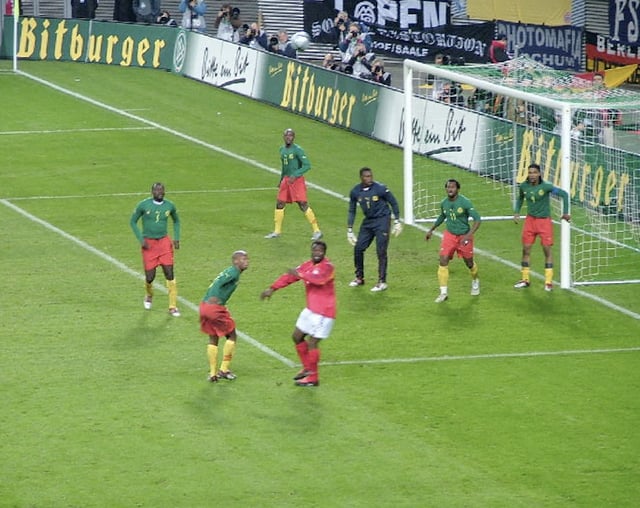
Cameroon faces Germany at Zentralstadion in Leipzig, 17 November 2004.
National policy strongly advocates sport in all forms.
Traditional sports include canoe racing and wrestling, and several hundred runners participate in the 40 km (25 mi) Mount Cameroon Race of Hope each year.[192] Cameroon is one of the few tropical countries to have competed in the Winter Olympics.
Sport in Cameroon is dominated by football.
Amateur football clubs abound, organised along ethnic lines or under corporate sponsors.
The national team has been one of the most successful in Africa since its strong showing in the 1982 and 1990 FIFA World Cups. Cameroon has won five African Cup of Nations titles and the gold medal at the 2000 Olympics.[193]
Cameroon was the host country of the Women Africa Cup of Nations in November–December 2016.[194] The women's football team is known as the "Indomitable Lionesses."
Human rights
The Office of the United Nations High Commissioner for Human Rights reports that Cameroon Government forces are responsible for killings, the excessive use of force, burning down of houses, arbitrary detentions and torture. UN figures indicate that more than 21,000 people have fled to neighboring countries, while 160,000 have been internally displaced by the violence, many reportedly hiding in forests. On 25 July 2018, UN High Commissioner for Human Rights Zeid Ra'ad Al Hussein expressed deep concern about reports of violations and abuses in the English-speaking Northwest and Southwest regions of Cameroon.[195]
See also
Index of Cameroon-related articles
Outline of Cameroon